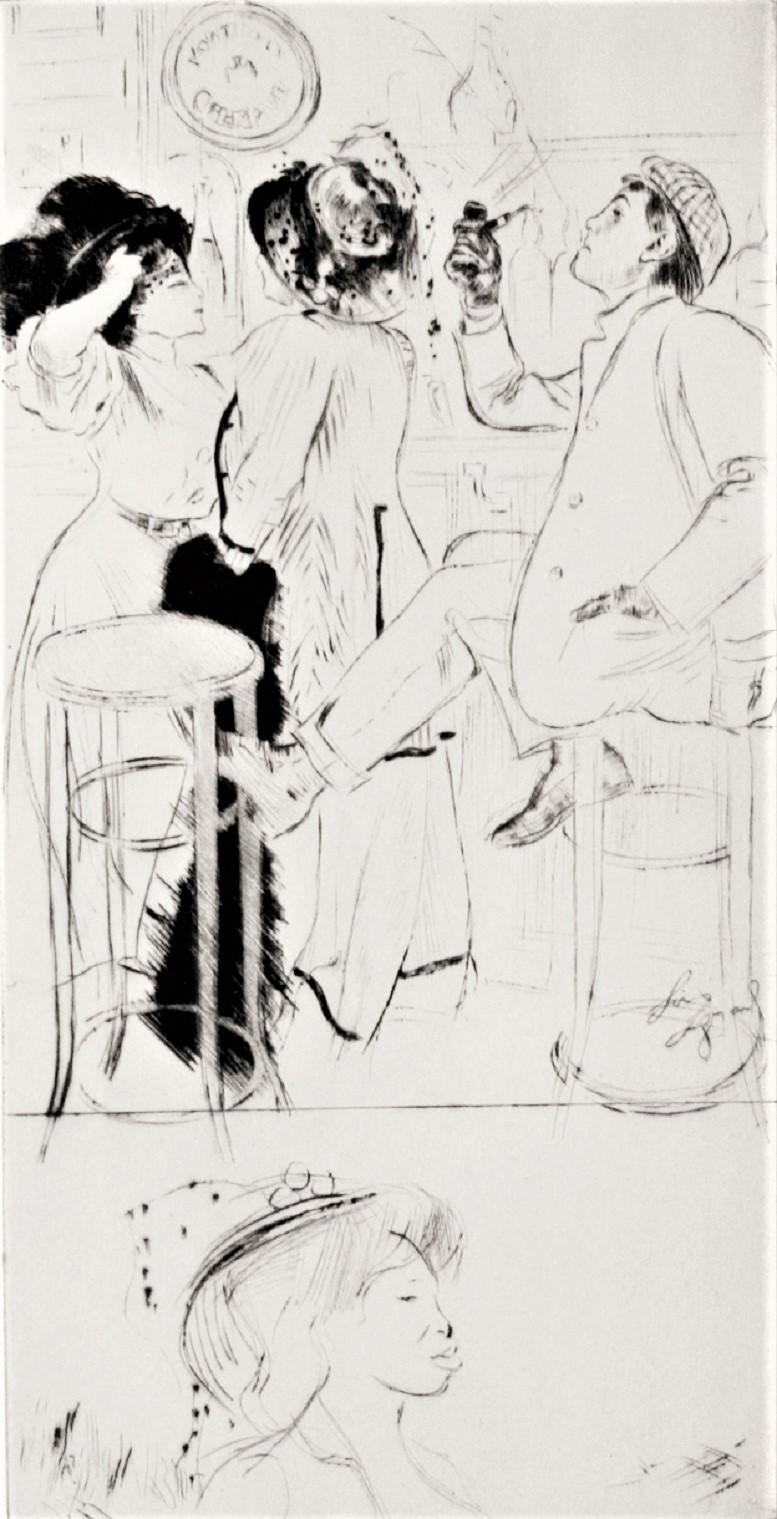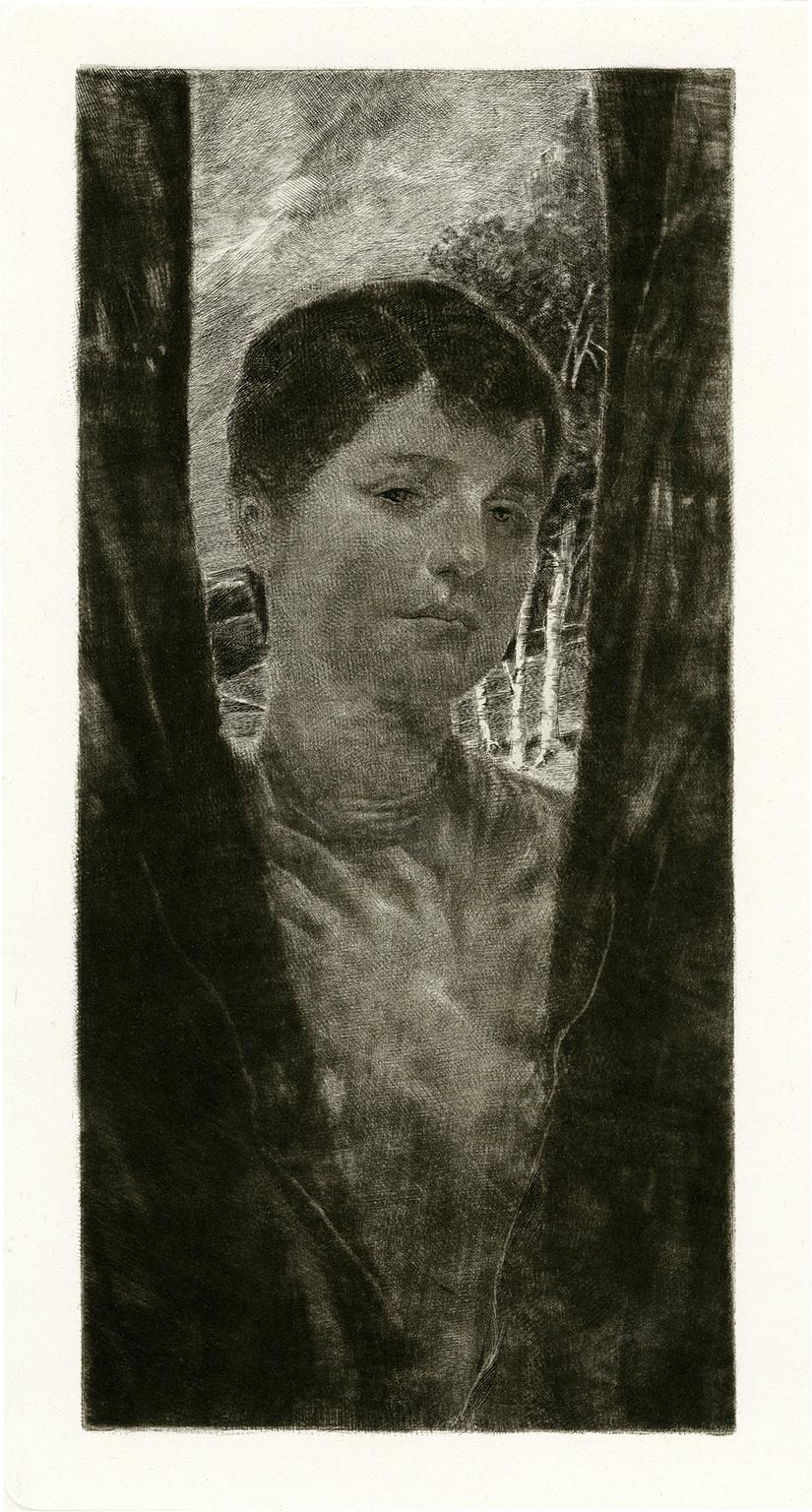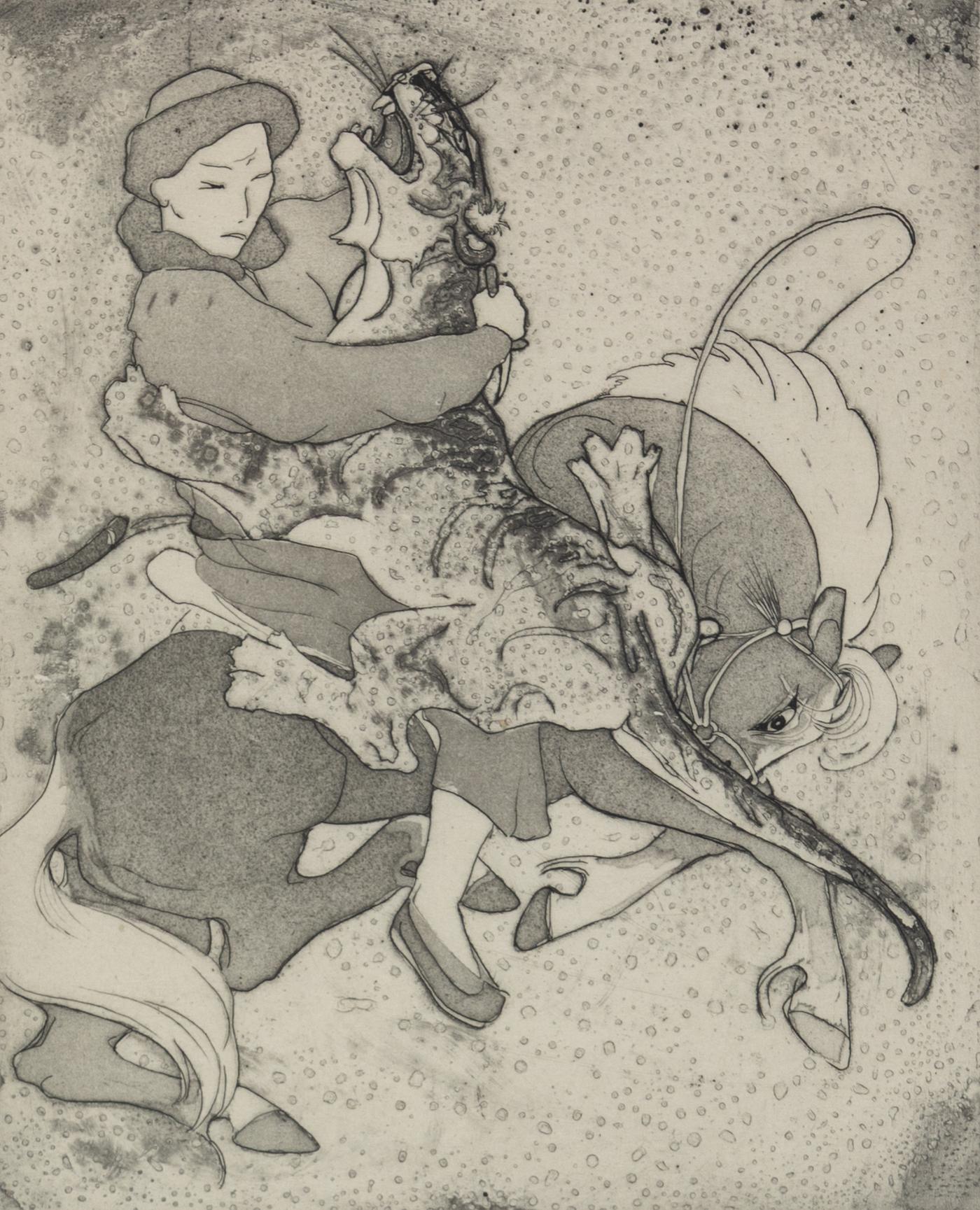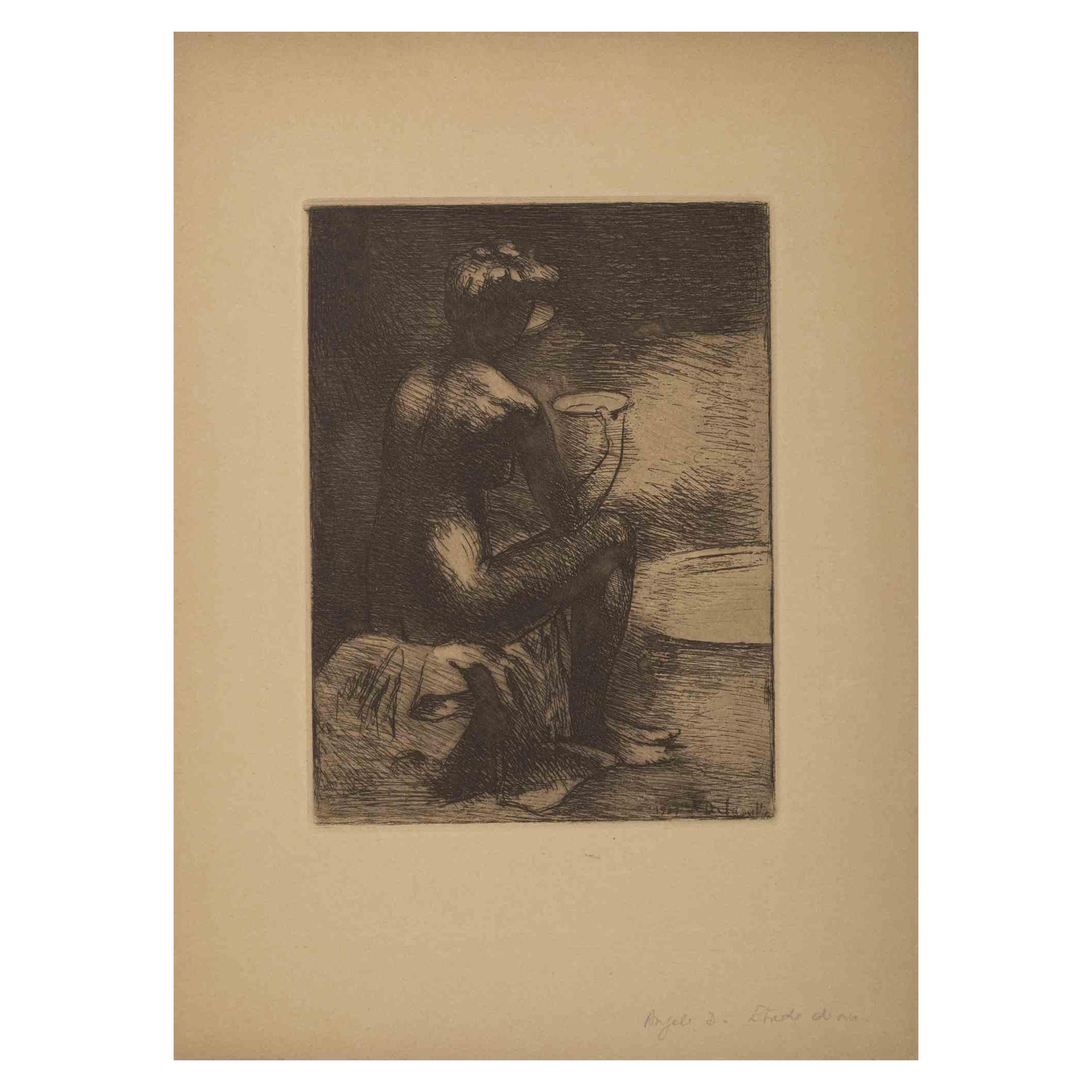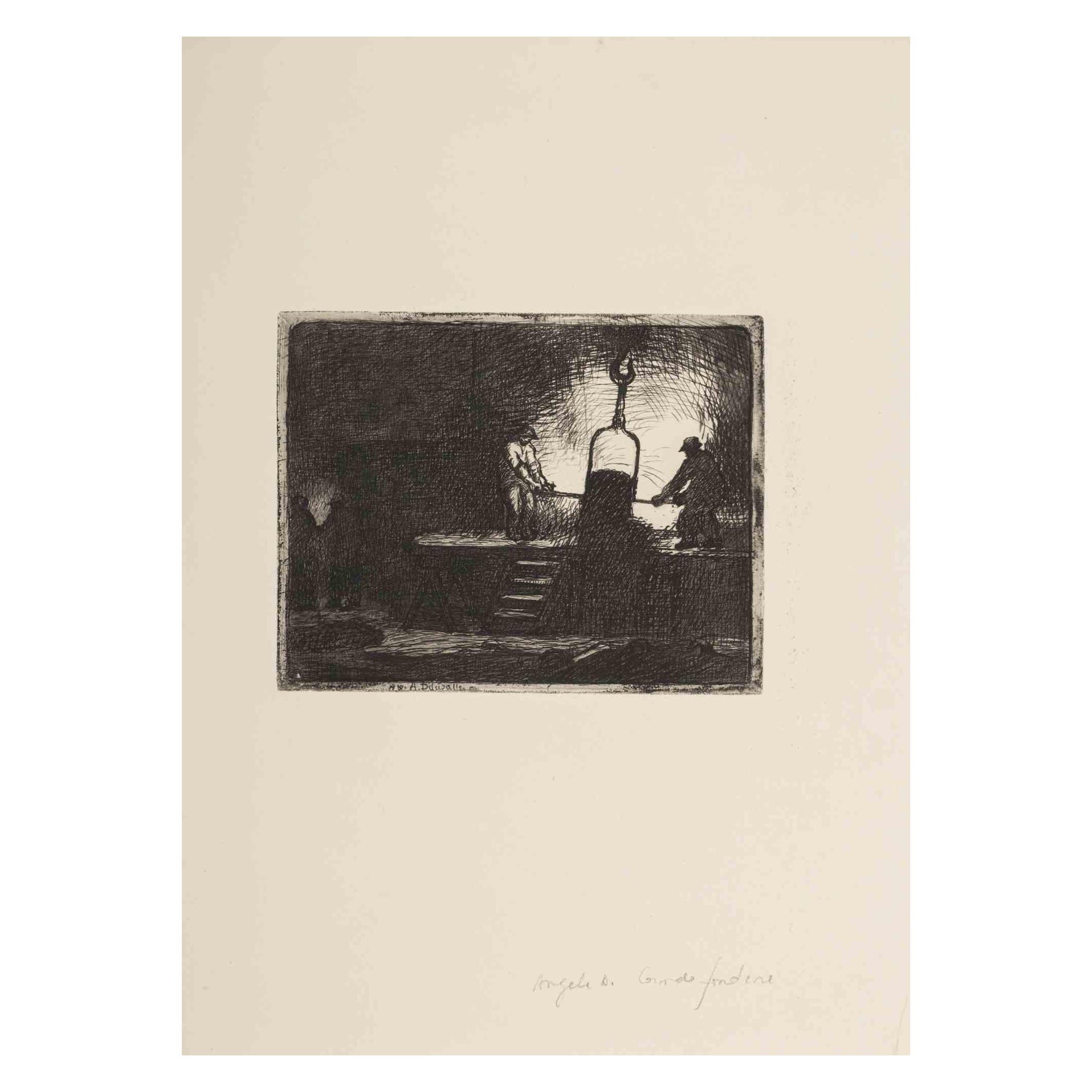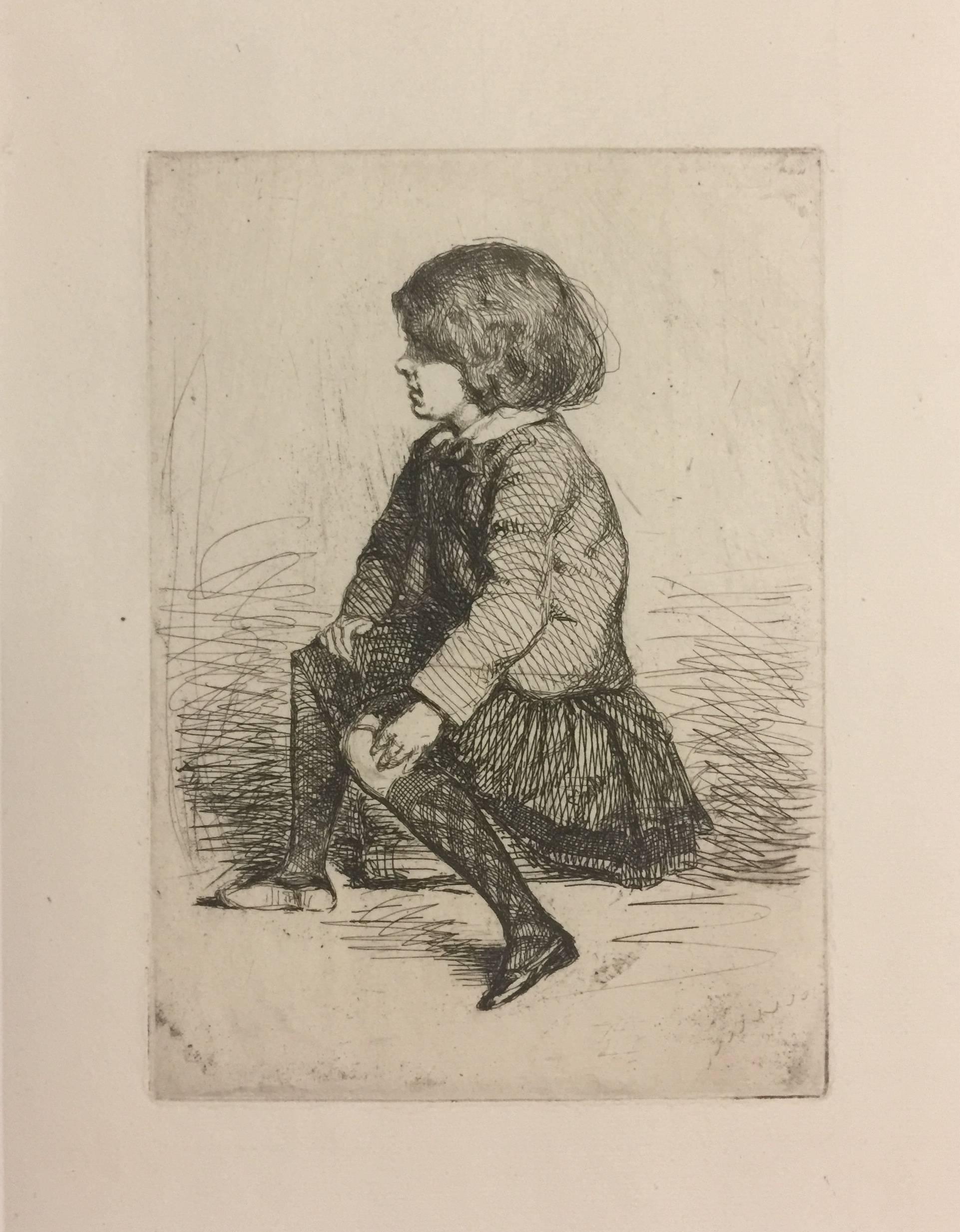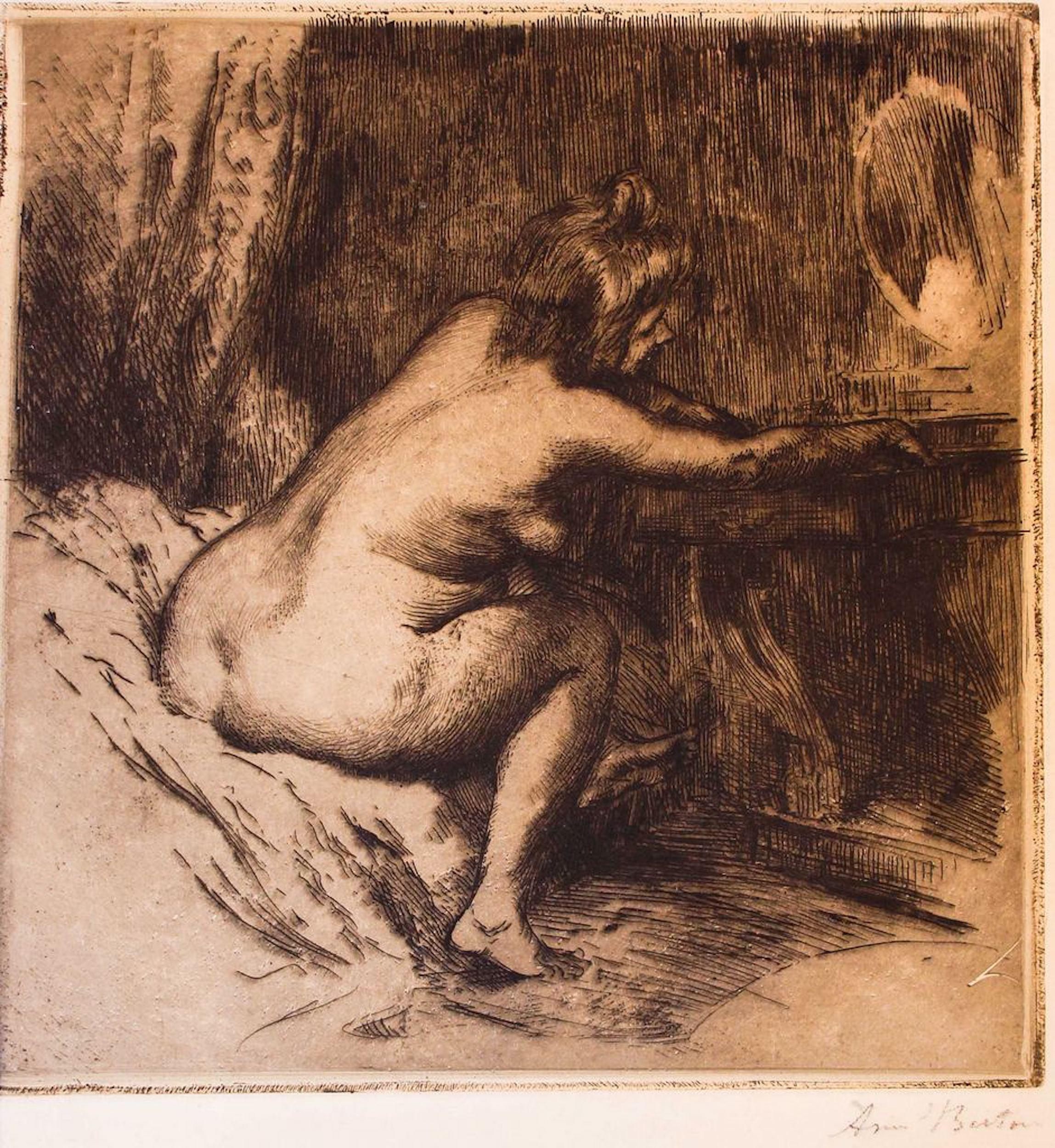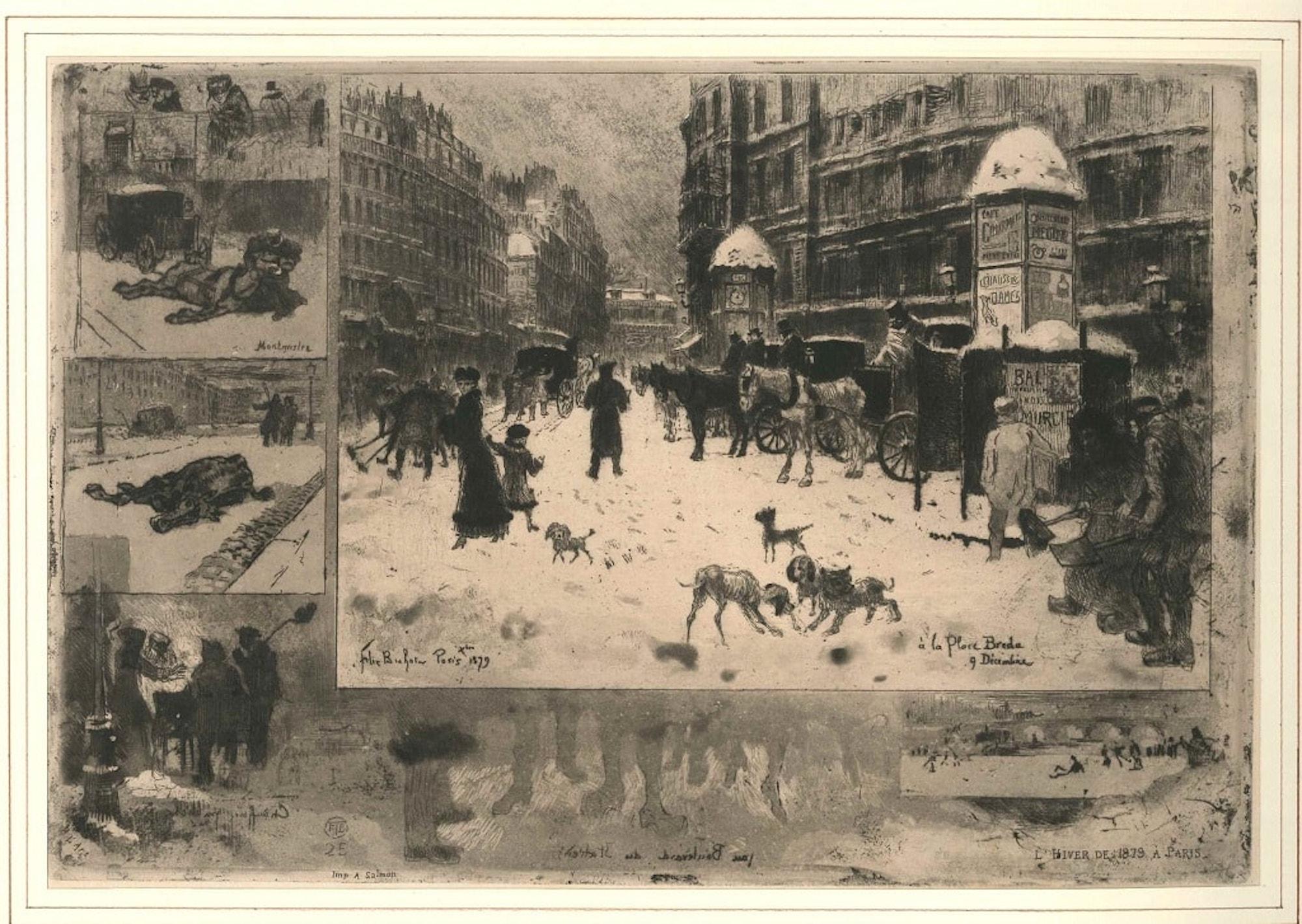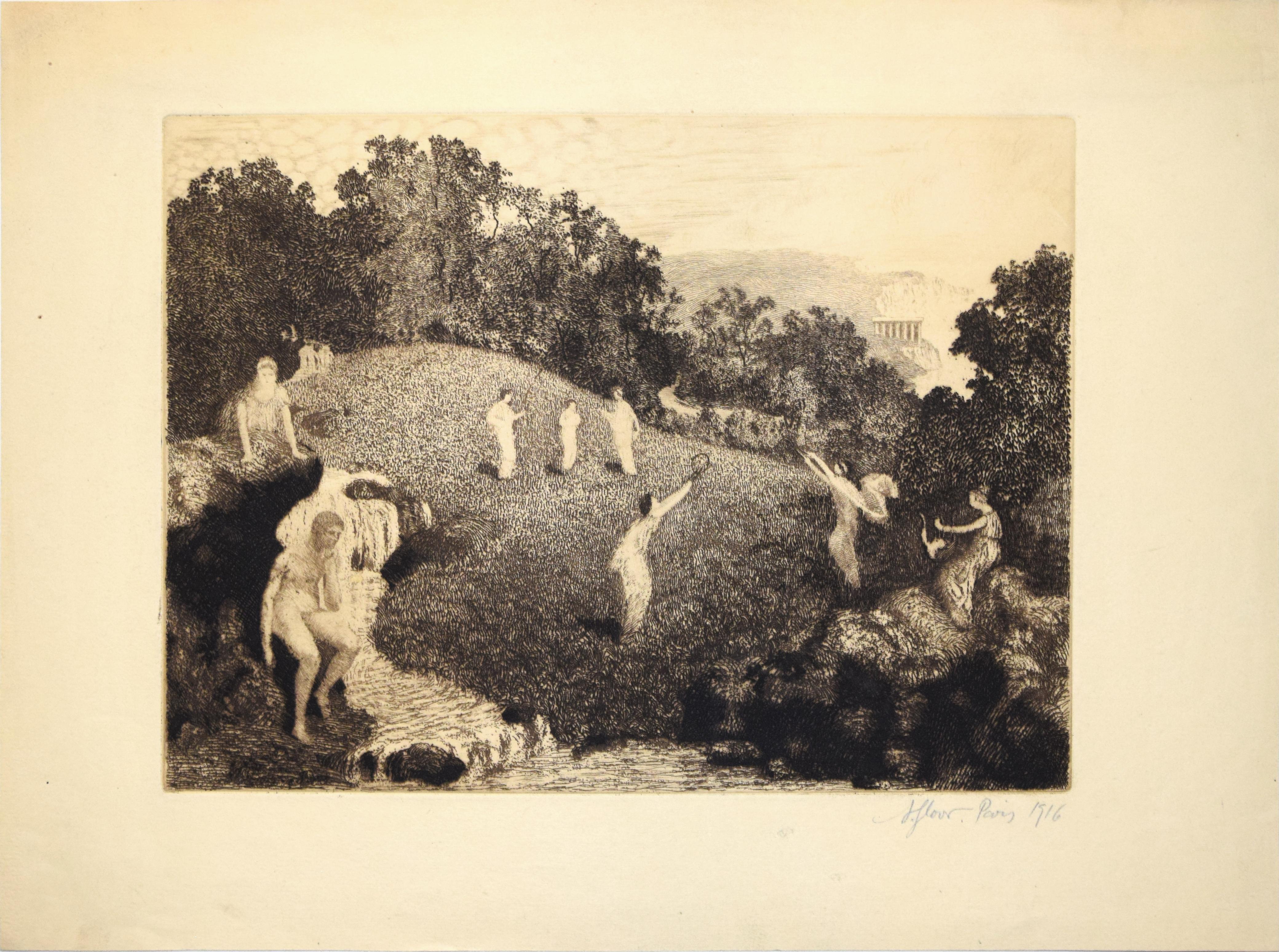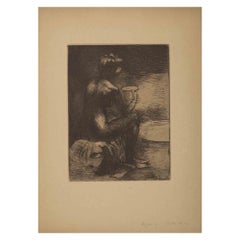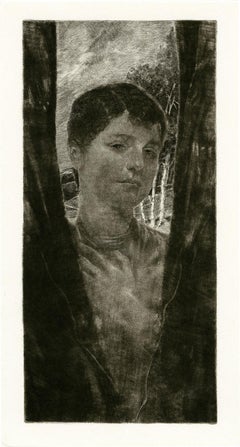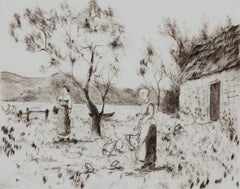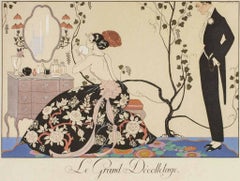
Le Grand décolletage - Original Etching by George Barbier - 1924
View Similar Items
Want more images or videos?
Request additional images or videos from the seller
1 of 5
George Barbier Le Grand décolletage - Original Etching by George Barbier - 19241924
1924
About the Item
- Creator:George Barbier (1882 - 1932, French)
- Creation Year:1924
- Dimensions:Height: 12.21 in (31 cm)Width: 17.72 in (45 cm)Depth: 0.04 in (1 mm)
- Medium:
- Movement & Style:
- Period:
- Condition:Insurance may be requested by customers as additional service, contact us for more information.
- Gallery Location:Roma, IT
- Reference Number:Seller: J-754861stDibs: LU65032426213
About the Seller
4.9
Platinum Seller
These expertly vetted sellers are 1stDibs' most experienced sellers and are rated highest by our customers.
1stDibs seller since 2017
6,753 sales on 1stDibs
Typical response time: 2 hours
More From This SellerView All
- Study for a Nude - Original Etching by A. Delasalle - Mid-20th CenturyBy Angèle DelasalleLocated in Roma, ITStudy for a Nude is a contemporary artwork realized by the French artist Angèle Delasalle in the Mid-20th Century. Original etching and drypoint. Si...Category
Mid-20th Century Post-Impressionist Figurative Prints
MaterialsEtching
- Working - Original Etching by A. Delasalle - Mid-20th CenturyBy Angèle DelasalleLocated in Roma, ITWorking is a contemporary artwork realized by the French artist Angèle Delasalle in the Mid-20th Century. Original etching and drypoint. Signed and ...Category
Mid-20th Century Post-Impressionist Figurative Prints
MaterialsEtching
- Seymour seatedBy James Abbott McNeill WhistlerLocated in Roma, ITNot signed. The American artist James Abbott McNeill Whistler can be considered a forerunner of the Post-Impressionist movement. Passepartout included : 53 x 37 cm Image Dimensions ...Category
Late 19th Century Post-Impressionist Figurative Prints
MaterialsEtching
- Les Allies a VersaillesBy George BarbierLocated in Roma, ITSigned on plate. From the portfolio “Le Bonheur du Jour” by George Barbier. Etching and Pochoir. Passepartout included : 49 x 34 cmCategory
1920s Post-Impressionist Figurative Prints
MaterialsEtching
- Woman at the Mirror - Etching by Armand Breton - 1920By Armand BretonLocated in Roma, ITHand signed. Etching and aquatint. Includes passepartout (49 x 34 cm ). This etching by Armand Breton is an example of the Post-Impressionism atmosphere at the beginning of the XX...Category
1920s Post-Impressionist Figurative Prints
MaterialsEtching
$453 Sale Price24% Off - La neige à Paris (Snow in Paris) - Etching by F. H. Buhot - 1879By Félix Hilaire BuhotLocated in Roma, ITWonderful etching, aquatint, drypoint, and wheel on laid ivory colored paper. Signed inside out on plate on the lower margin at the center. Each image of the composition is hand-titled on the plate on lower margins. Fourth state on nine. Edition of the “L’Art. Excellent conditions, including ivory colored cardboard passe-partout (cm 33.5 x 49). The print has been given the titles of “L’Hiver à Paris “ or “ La Neige à Paris”. The modern artwork represents the rigorous winter of 1879 with Arctic temperatures and vast quantities of snow covered the Parisian streets. Reference: B.G. I28 The present print, one of his best known, exemplifies these preoccupations. The published version appeared in the journal L'Art (n° 314) in January 1881. As Bourcard clearly states "There were numerous trial proofs pulled and an extraordinary variety of printings in the various impressions of this plate. There exist a few rare artist's proofs of the state before the words: L'Art, the number 25, L'Hiver de 1879 à Paris." Félix Hilaire Buhot...Category
1870s Post-Impressionist Figurative Prints
MaterialsEtching, Aquatint
You May Also Like
- SportsmenBy Louis LegrandLocated in Storrs, CTSportsmen. 1908. Etching and drypoint. Exsteens 271.i/ii. 11 1/4 x 5 3/4 (sheet 17 3/8 x 12 1/4). Series: Les Bars. From the first state edition of 30 proofs with the remarque sketch...Category
Early 1900s Post-Impressionist Figurative Prints
MaterialsDrypoint, Etching
$875 Sale Price50% Off - Erinnerung (Remembrance) — Turn-of-the Century Romantic EtchingBy Max KlingerLocated in Myrtle Beach, SCMax Klinger, 'Erinnerung (Remembrance)', etching and aquatint, 1896. A fine, richly inked impression, on off white, wove paper, with full margins (1 3/4 to 3 1/8 inches), in excellen...Category
1890s Post-Impressionist Figurative Prints
MaterialsAquatint, Etching
$440 Sale Price20% Off - Charlotte and Amalia by Lélia Pissarro - EtchingBy Lelia PissarroLocated in London, GBCharlotte and Amalia by Lélia Pissarro (b. 1963) Etching 22.7 x 27.5 cm (9 x 10 ⁷/₈ inches) Signed lower left, Lélia Pissarro Numbered lower right, 2/15 Artist biography: Born in P...Category
1990s Post-Impressionist Figurative Prints
MaterialsEtching
- Chatter by Orovida Pissarro - EtchingBy Orovida PissarroLocated in London, GBChatter by Orovida Pissarro (1893-1968) Etching 26 x 19 cm (10 ¹/₄ x 7 ¹/₂ inches) Signed and dated lower right Orovida 1927 Inscribed lower left Trial proof no. 18/25 and titled lower middle Artist biography: Orovida Camille Pissarro, Lucien and Esther Pissarro’s only child, was the first woman in the Pissarro family as well as the first of her generation to become an artist. Born in Epping, England in 1893, she lived and worked predominantly in London where she became a prominent member of several British arts clubs and societies. She first learned to paint in the Impressionist style of her father, but after a brief period of formal study with Walter Sickert in 1913 she renounced formal art schooling. Throughout her career, Orovida always remained outside of any mainstream British art movements. Much to Lucien's disappointment she soon turned away from naturalistic painting and developed her own unusual style combining elements of Japanese, Chinese, Persian and Indian art. Her rejection of Impressionism, which for the Pissarro family had become a way of life, together with the simultaneous decision to drop her famous last name and simply use Orovida as a ‘nom de peintre’, reflected a deep desire for independence and distance from the weight of the family legacy. Orovida's most distinctive and notable works were produced from the period of 1919 to 1939 using her own homemade egg tempera applied in thin, delicate washes to silk, linen or paper and sometimes embellished with brocade borders. These elegant and richly decorative works generally depict Eastern, Asian and African subjects, such as Mongolian horse...Category
1920s Post-Impressionist Figurative Prints
MaterialsEtching
- Man & Beast by Orovida Pissarro - EtchingBy Orovida PissarroLocated in London, GB*UK BUYERS WILL PAY AN ADDITIONAL 20% VAT ON TOP OF THE ABOVE PRICE Man & Beast by Orovida Pissarro (1893-1968) Etching 27 x 22 cm (10 ⁵/₈ x 8 ⁵/₈ inches) Signed and dated lower right, orovida 1924 Inscribed lower left, Final state no 12/40 and titled lower centre Artist biography: Orovida Camille Pissarro, Lucien and Esther Pissarro’s only child, was the first woman in the Pissarro family as well as the first of her generation to become an artist. Born in Epping, England in 1893, she lived and worked predominantly in London where she became a prominent member of several British arts clubs and societies. She first learned to paint in the Impressionist style of her father, but after a brief period of formal study with Walter Sickert in 1913 she renounced formal art schooling. Throughout her career, Orovida always remained outside of any mainstream British art movements. Much to Lucien's disappointment she soon turned away from naturalistic painting and developed her own unusual style combining elements of Japanese, Chinese, Persian and Indian art. Her rejection of Impressionism, which for the Pissarro family had become a way of life, together with the simultaneous decision to drop her famous last name and simply use Orovida as a ‘nom de peintre’, reflected a deep desire for independence and distance from the weight of the family legacy. Orovida's most distinctive and notable works were produced from the period of 1919 to 1939 using her own homemade egg tempera applied in thin, delicate washes to silk, linen or paper and sometimes embellished with brocade borders. These elegant and richly decorative works generally depict Eastern, Asian and African subjects, such as Mongolian horse...Category
1920s Post-Impressionist Animal Prints
MaterialsEtching
- "Mlle Landsberg" (grade planche, pl. 16)By Henri MatisseLocated in Missouri, MO"Mlle Landsberg" (grade planche, pl. 16), 1914 Henri Matisse (French, 1869-1954) Signed and Numbered Lower Right Edition 12/15 Image size: 7 7/8 x 4 5/16 inches Sheet size: 17 11/16 x 12 1/2 inches With frame: 19 1/2 x 14 1/2 inches Henri Matisse came from a family who were of Flemish origin and lived near the Belgian border. At eight o'clock on the evening of December 31, 1869, he was born in his grandparents' home in the town of Le Cateau in the cheerless far north of France. His father was a self-made seed merchant who was a mixture of determination and tightly coiled tension. Henri had no clear idea of what he wanted to do with his life. He was a twenty-year-old law clerk convalescing from appendicitis when he first began to paint, using a box of colors given to him by his mother. Little more than a year later, in 1890, he had abandoned law and was studying art in Paris. The classes consisted of drawing from plaster casts and nude models and of copying paintings in the Louvre. He soon rebelled against the school's conservative atmosphere; he replaced the dark tones of his earliest works with brighter colors that reflected his awareness of Impressionism. Matisse was also a violinist; he took an odd pride in the notion that if his painting eye failed, he could support his family by fiddling on the streets of Paris. Henri found a girlfriend while studying art, and he fathered a daughter, Marguerite, by her in 1894. In 1898 he married another woman, Amelie Parayre. She adopted the beloved Marguerite; they eventually had two sons, Jean, a sculptor and Pierre who became an eminent art dealer. Relations between Matisse and his wife were often strained. He often dallied with other women, and they finally separated in 1939 over a model who had been hired as a companion for Mme. Matisse. She was Madame Lydia, and after Mme. Matisse left, she remained with Matisse until he died. Matisse spent the summer of 1905 working with Andre Derain in the small Mediterranean seaport of Collioure. They began using bright and dissonant colors. When they and their colleagues exhibited together, they caused a sensation. The critics and the public considered their paintings to be so crude and so roughly crafted that the group became known as Les Fauves (the wild beasts). By 1907, Matisse moved on from the concerns of Fauvism and turned his attention to studies of the human figure. He had begun to sculpt a few years earlier. In 1910, when he saw an exhibition of Islamic art, he was fascinated with the multiple patterned areas and adapted the decorative universe of the miniatures to his interiors. As a continuation of his interest in the "exotic", Matisse made extended trips to Morocco in 1912 and 1913. At the end of 1917, Matisse moved to Nice; he would spend part of each year there for the remainder of his life. A meticulous dandy, he wore a light tweed jacket amd a tie when he painted. He never used a palette, but instead squeezed his colors on to plain white kitchen dishes...Category
1910s Fauvist Figurative Prints
MaterialsEtching, Drypoint
Price Upon Request
Recently Viewed
View AllMore Ways To Browse
Edouard Chimot On Sale
Felix de Weldon On Sale
Giuseppe Guerreschi
Godefroy Engelmann On Sale
Henry De Groux
Jean Jansem On Sale
Jean Louis Prevost
Jolly Flatboatmen
Ludovico Caracciolo On Sale
Pere Ubu
Piero Cesaroni On Sale
Pierre Bonnard On Sale
Robert Cottingham On Sale
Alejandro Alfonso On Sale
Alex Katz On Sale
Bruno Caruso
Church Of St Marcellino
Curtis Kulig On Sale
